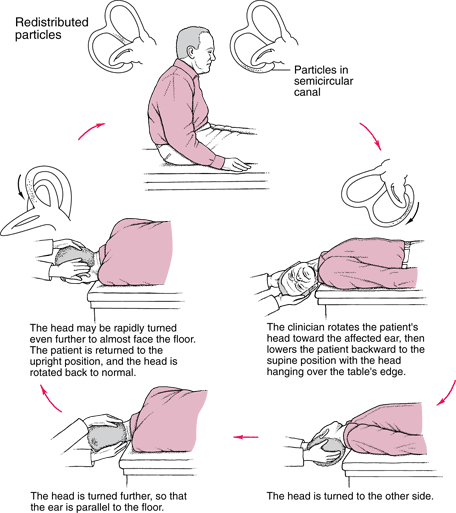


Application of canalith repositioning maneuvers in instances that are unlikely to be beneficial and more likely to cause worsening symptoms, such as vestibular neuritis, have likely also shaped practice patterns in some ED physicians.
Vertigo maneuver how to#
They found that prior poor experiences with the technique, such as intolerability of the procedure or worsening of symptoms, along with forgetting how to perform the procedure, were common reasons for not performing DHT or Epley. A recent study 7 interviewing 50 practicing emergency medicine physicians examined factors that led to utilization of DHT and Epley maneuvers. 5, 6īarriers to utilization of Dix-Hallpike testing and canalith repositioning maneuvers by ED physicians are also important to recognize. Both of these primary care trials were conducted in family practice clinics and reported higher rates of symptom improvement in patients undergoing Epley’s maneuver at first visit but did not show any significant difference in proportion of symptom-free patients between study and control groups beyond 1 week of follow-up. These primary care visits are likely more representative of the patients seen in the ED because both are more likely to be visits due to acute symptoms as opposed to specialty clinic visits where patients may be more chronically symptomatic. Only two trials recruited from a primary care population. This rings true, because subjects in nine of 11 studies were from specialty (dizziness or ear–nose–throat) clinics and suffered ongoing symptoms for weeks. 4 The authors attributed this to recruitment of patients from various settings as well as the different length of symptoms. Specifically for the end point of resolution of symptoms, however, heterogeneity was high (I 2 = 71%) and number of subjects was low ( n = 273).
Vertigo maneuver trial#
The authors of the systematic review assessed the quality of the included trial by examining sequence generation, allocation concealment, blinding, incomplete outcome data, selective reporting, and other sources of bias using the Cochrane “risk of bias” tool. Overall, there was a low risk of bias in all included 11 studies, a reassuring finding.

4 While Epley appears to be associated with higher rates of resolution of symptoms of vertigo, the absolute rates of resolution of symptoms were still only 56% compared to the 21% of the control group. The measurement of the primary patient-oriented outcome was the resolution of symptoms, particularly vertigo however, this and other symptoms were variably reported and reported at different durations of follow-up. Nausea was the most commonly reported symptom, which could result in patients not tolerating the maneuver. However, there were no reported serious complications of the treatments. When compared to a control (no maneuver) or a sham maneuver (273 patients total), the Epley increased the likelihood of symptom resolution (odds ratio = 4.4, 95% confidence interval = 2.6 to 7.4, absolute risk difference = 35%, NNT = 3). Subjects were 18- to 90-year-old, mostly female (74%), and all were diagnosed clinically. Of the five studies meeting these criteria and therefore included in the NNT calculation, all were prospective randomized control trials. Here we only report the analysis of the data where Epley maneuver was compared to control or a sham maneuver and where complete resolution of symptoms is reported as the primary outcome (some trials reported conversion of DHT from positive to negative as outcome). 4 Five trials compared the Epley maneuver against a sham maneuver, three against other canalith repositioning maneuvers, and three against a control (no treatment, medication only, or restricted positioning). The systematic review included 11 randomized trials with a total of 745 participants. The authors also examined adverse events associated with the maneuver. 4 The primary outcome was complete resolution for vertigo symptoms.

The Cochrane review discussed here examined the effectiveness of the Epley maneuver for posterior canal BPPV. Other canalith repositioning maneuvers include the Semont, Brandt-Daroff, and Gans. 3 It should be noted that the first movement of the Epley is the end position of the positive DHT.
Vertigo maneuver series#
2 The Epley maneuver was invented as a way to move the ear debris out of the semicircular canal and involves a series of four sequential movements. 1 The condition is usually brought on by a rapid change in head position, and diagnosis can be confirmed by a positive Dix-Hallpike test (DHT). Benign paroxysmal positional vertigo (BPPV) is one of the most common causes of vertigo and is thought to be caused by free-floating debris primarily in the posterior semicircular canal.


 0 kommentar(er)
0 kommentar(er)
